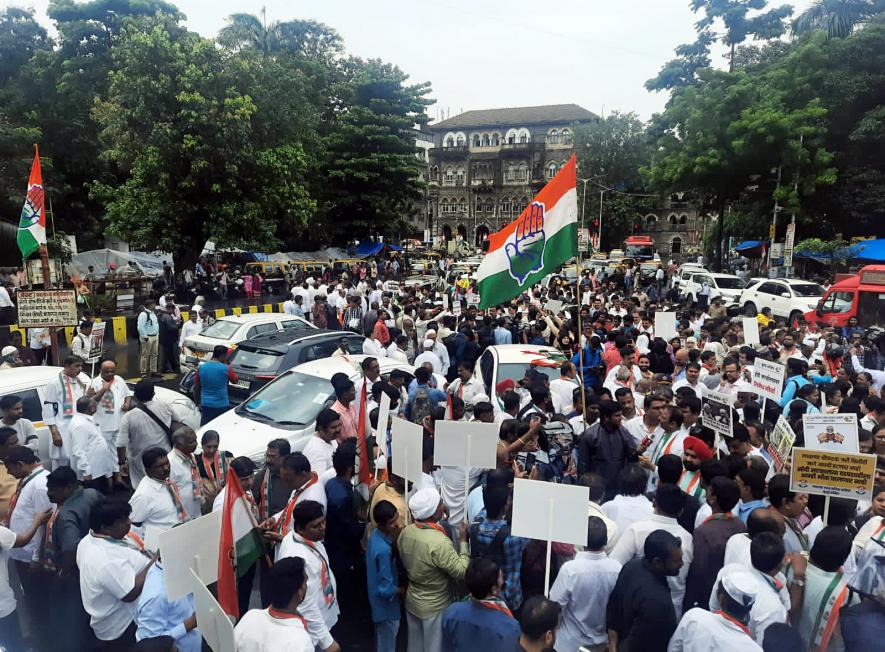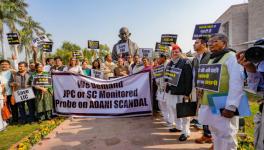The Road Forward for Congress

Representational use only.Image Courtesy: ANI
With an overwhelming majority in Parliament and well-organised Rashtriya Swayamsevak Sangh (RSS)-Bharatiya Janata Party (BJP) spreading in the North-east and South India, too, Union Home Minister Amit Shah can, of course, dream that the BJP is there to remain in power for the next 40 to 50 years. He obviously believes that the Hindu-Muslim binary will take good care of that. The economic policy of the party is hardly any different from the neo-liberal policy of Prime Minister Manmohan Singh and his predecessor PV Narasimha Rao which was a great departure from Jawaharlal Nehru's democratic socialism, close to that of the Left-wing of the British Labour Party. The beneficiaries of their economic policies, too, are the same, including the Ambanis and the Tatas. And, there is no reason to doubt that Gautam Adani, too, would have been as beholden to the Congress as he is to the BJP.
The problem with such an overwhelming majority of the ruling party is that, coupled with the Modi Government's no-no to Parliamentary Standing Committee and Select Committees to consider the Bills moved by the Treasury Benches, it makes the authorities brazenly autocratic, unmindful of people's attitudes and responses and over-assertive. It leads not only to the pasting of Narendra Modi's pictures on food bags distributed to the poor and COVID-19 vaccines but also to the projection of his personality cult in almost everything the government does. No wonder the image of Modi in the country is nearly that of a monarch than that of a democratic Prime Minister, and he is projected as the "anna-data" so that it becomes incumbent upon the people to vote for the BJP to prove that they are not "namak-haram". Government funds, thus, get used for the electoral interests of the ruling party.
For the common people, the socio-economic policies of the Modi government have only brought unemployment, price rise, communal violence, and an increase in gangsterism and crime. The recent agitations of the youth in Uttar Pradesh and Bihar against the new recruitment policy of the armed forces and for an increase in employment opportunities clearly showed the extent of distress the RSS-BJP policies have caused in the society, the youth in particular. The BJP has responded to these by employing what it is good at – distraction, i.e., increasing anti-Muslim communalism and casteist policies.
The only way such a situation can be countered is by having a democratic dispensation, which is inconceivable without a strong Opposition party capable of providing an alternative government. The problem is that although Congress is on the wane, there is no other national party in the country than Congress. The communist parties have only gotten weaker of late and are struggling to strengthen themselves. All other parties, including the Samajwadi (Socialist) Party, Rashtriya Janata Dal (RJD), and Dravida Munnetra Kazhagam (DMK), are regional parties. The Trinamool Congress (TMC) of Mamata Banerjee and Arvind Kejriwal's Aam Aadmi Party (AAP) have of late begun trying to expand their spread but have still a long way to go to become all-India parties.
Ironically, the silver lining for Congress lies in opposition to the reckless implementation of the neo-liberal policies by the BJP government. The present dispensation under Modi may blame COVID-19 as the only reason for India's economic woes. Still, the fact remains that the Indian economy took the first big hit in November 2016 after demonetisation and was hit for the second time in quick succession on July 1, 2017, with the faulty implementation of the Goods and Services Tax (GST).
Several skewed fiscal measures addressing the supply side instead of the demand side of the economy further accentuated the problem. The worst is the unfolding economic disparity that has led to a phenomenal increase in the wealth of the super-rich at the cost of stripping people of even the basic necessities. The recent imposition of 5% to 18% GST on basic food items, essential consumables, and critical health services amid spiralling inflation shows that the ruling dispensation has too much faith in its leader's popularity and the tested formula of dividing the society by using the Hindu-Muslim binary. But similarly, it is also true that there is no exception to the fact that economic woes have the potential to bring down any government, how-so-ever strong it may appear. This is precisely where lies the silver lining for Congress.
It is gratifying to see that Congress realises its responsibility and has already drawn up plans to put up a good fight in the 2024 elections. Rahul Gandhi's plan for a 148-day "Bharat Jodo" pad-yatra from Kanyakumari to Kashmir, which may be increased by some more days, scheduled to begin in or before October, will surely go a long way in boosting his popularity and bringing him closer to the people. The personal popularity of a leader, however, is not enough for a party to win elections, which requires a well-organised party down to the town, block, taluka, and village level.
The party has also decided to strengthen its Seva Dal down to the village level, which would surely help. Despite the dwindling vote share of Congress in most states, committed volunteers of the Seva Dal can still be found in almost every village in the country. It is time indeed when the party must strengthen its organisations like Seva Dal, Committees, and students' unions at all levels and expand its active work among the people so that it can get a good representation in Parliament to play the role of at least a strong Opposition party. The party, of course, has decided to hold its elections for the next AICC, but that will take three years to complete, which will, obviously, be after the next elections. Therefore, its immediate task must be to urgently strengthen its present organisational set-up and prepare for the next elections.
It is also in the interest of the party to work in close tandem on people-centric social and economic issues with the Left parties and other like-minded parties like RJD, who are also fearlessly secular. The Left parties, in particular, have a strong pan-India presence as they have continued to work on workers' and farmers' issues despite not getting proportionate electoral results. Synergy among these parties is bound to create a credible anti-RSS/ BJP alternative as a multitude of electorates are just waiting to call the Sangh's bluff that there is no alternative (TINA) factor.
The problem with the Congress party, however, is that although it has many competent leaders, its Working Committee has almost no role in decision-making, which has got concentrated in the Nehru-Gandhi family. The role that was earlier played by leaders like Ahmed Patel, K. Kamaraj, and many Congress presidents is now played by nobody. The Nehru-Gandhi family takes all decisions: Sonia Gandhi, Rahul Gandhi, and Priyanka Gandhi-Vadra. As a result, the party has begun to be led in State, District, Taluka, and Block committees by sycophants and not representatives of Congressmen. Many genuine leaders have, therefore, broken away from the party and formed their separate "Congress" parties like the Trinamool Congress (TMC) in West Bengal and NCP in Maharashtra and many other states.
The party must, therefore, restore the decision-making role of the Congress Working Committee (CWC) and stop taking its decisions in the Nehru-Gandhi family. It could also set up a committee of senior leaders like Ghulam Nabi Azad, Anand Sharma, Kamal Nath, and Digvijay Singh to contact the breakaway Congress groups and persuade them to remerge with the party. The beginning, however, could be made not with Banerjee or Sharad Pawar but with other states' leaders.
Ideally, the party could follow up these efforts and consultations by convening a joint meeting of the Congress and these breakaway groups under the leadership of a presidium of the Congress and all the breakaway groups and conclude it with a joint statement announcing their unity.
In the meantime, the party could also set up a committee of senior leaders and experts to draft a fresh Manifesto, which may not return to Jawaharlal Nehru's economic policies. Still, it must not revert to Manmohan Singh's neo-liberalism either but could benefit from studying the policies of countries like Vietnam, Brazil and Cuba and the efforts now being made by some Social-Democratic parties of European countries to follow pro-people policies. To bring people back on its side, Congress needs to expose the direct and indirect implications of the BJP government's neo-liberal policies on the poor and middle classes and, simultaneously, take its freshly drawn manifesto to the people in all manners possible.
As of now, the only difference between the Congress and the BJP, if at all, is in their approach to communalism and casteism, though even that got diluted when Rahul Gandhi tried to present his Hindu image and the party's selection of its electoral candidates on communal and casteist basis. It was shocking that instead of contrasting his party's principled policy on secularism and anti-casteism with the BJP's communal and casteist approach, he chose to project himself as no less a Hindu than Modi and a Kashmiri Pandit to boot. It is good that he has given up that position and reasserted his secular approach.
The writer is a senior political commentator and writes on Indian and South Asian politics. Views are personal.
Get the latest reports & analysis with people's perspective on Protests, movements & deep analytical videos, discussions of the current affairs in your Telegram app. Subscribe to NewsClick's Telegram channel & get Real-Time updates on stories, as they get published on our website.























